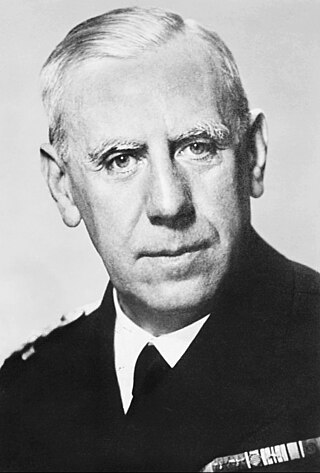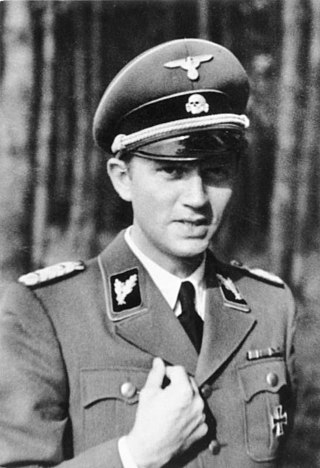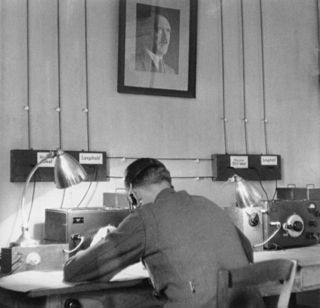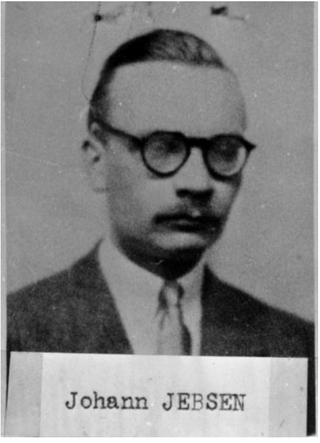Related Research Articles

Wilhelm Franz Canaris was a German admiral and the chief of the Abwehr from 1935 to 1944. Canaris was initially a supporter of Adolf Hitler, and the Nazi regime. Following the German invasion of Poland in 1939, however, Canaris turned against Hitler and committed acts of both passive and active resistance during the war.

Werwolf was a Nazi plan which began development in 1944, to create a resistance force which would operate behind enemy lines as the Allies advanced through Germany in parallel with the Wehrmacht fighting in front of the lines. There is some argument that the plan, and subsequent reports of guerrilla activities, were created by Joseph Goebbels through propaganda disseminated in the waning weeks of the war through his "Radio Werwolf", something that was not connected in any way with the military unit.

The Venlo incident, was a covert operation carried out by the German Nazi Party's Sicherheitsdienst (SD) on 9 November 1939, which resulted in the capture of two British Secret Intelligence Service agents five metres (16 ft) from the German border, on the outskirts of the Dutch city of Venlo.

Walter Friedrich Schellenberg was a German SS functionary during the Nazi era. He rose through the ranks of the SS, becoming one of the highest ranking men in the Sicherheitsdienst (SD) and eventually assumed the position as head of foreign intelligence for Nazi Germany following the abolition of the Abwehr in 1944.

SMERSH was an umbrella organization for three independent counter-intelligence agencies in the Red Army formed in late 1942 or even earlier, but officially announced only on 14 April 1943. The name SMERSH was coined by Joseph Stalin. The formal justification for its creation was to subvert German attempts to infiltrate the Red Army on the Eastern Front.
Kampfgeschwader 200 was a German Luftwaffe special operations unit during World War II. The unit carried out especially difficult bombing and transport operations and long-distance reconnaissance flights, tested new aircraft designs and operated captured aircraft.

Reinhard Gehlen was a German career intelligence officer who served the Weimar Republic, Nazi Germany, the U.S. intelligence community, and the NATO-affiliated Federal Republic of Germany during the Cold War.

The Brandenburgers were members of Nazi Germany's Wehrmacht special forces unit during World War II.

Generalmajor Erwin Heinrich René Lahousen, Edler von Vivremont was a high-ranking Abwehr official during the Second World War, as well as a member of the German Resistance and a key player in attempts to assassinate Adolf Hitler on 13 March 1943 and 20 July 1944.
Operation Seagull I was an Abwehr II sanctioned mission devised in May 1942. The plan was the brainchild of Kurt Haller and an expert from Abwehr I-Wi (economic). The plan envisioned the use of an Abwehr agent to sabotage the North Scottish power station at Fort William.
Friesack Camp or Camp Friesack was a special World War II prisoner of war camp where a group of Irishmen serving in the British Army volunteered for recruitment and selection by Abwehr II and the German Army. The camp was designated Stalag XX-A (301) and located in the Friesack area, Brandenburg region. The training and selection by Abwehr II and the German Army occurred during the period 1940–1943.
John Codd was an Irish-born British Army corporal during World War II, who went on to serve in the German Intelligence service (Abwehr) and the Sicherheitsdienst, the foreign intelligence arm of the SS.

The Azerbaijani Legion was one of the foreign units of the Wehrmacht. It was formed in December 1941 on the Eastern Front as the Kaukasische-Mohammedanische Legion and was re-designated 1942 into two separate legions, the North Caucasian legion and the Azerbaijani legion. It was made up mainly of former Azerbaijani POW volunteers but also volunteers from other peoples in the area. It was part of the Ostlegionen. It was used to form the 162nd (Turkistan) Infanterie-Division of the Wehrmacht in 1943. similar to other Ostlegionen, it was organised to replenish the dwindling German manpower on the Eastern front and to "save the German blood at the front"
The Geheime Feldpolizei, shortened to GFP, was the secret military police of the German Wehrmacht until the end of the Second World War (1945). Its units carried out plainclothes and undercover security work in the field. Their operations included clandestine operations, counterpropaganda, counterinsurgency, counterintelligence, creation of a counterinsurgency intelligence network, detection of treasonable activities, infiltration of resistance movements, gathering intelligence and destroying targets, protecting military installations, assisting the German Army (Heer) in courts-martial investigations, tracking and raiding targets to capture or kill, and setting-up security checkpoints in high-risk areas. GFP personnel, who were also classed as Abwehrpolizei, operated as an executive branch of the Abwehr, detecting resistance activity in Germany and in occupied France. They were also known to carry out torture and executions of prisoners.

The Abwehr was the German military-intelligence service for the Reichswehr and the Wehrmacht from 1920 to 1945. Although the 1919 Treaty of Versailles prohibited the Weimar Republic from establishing an intelligence organization of their own, they formed an espionage group in 1920 within the Ministry of Defence, calling it the Abwehr. The initial purpose of the Abwehr was defense against foreign espionage: an organizational role that later evolved considerably. Under General Kurt von Schleicher the individual military services' intelligence units were combined and, in 1929, centralized under Schleicher's Ministeramt within the Ministry of Defence, forming the foundation for the more commonly understood manifestation of the Abwehr.
Operation Scherhorn or Operation Berezino or Operation Beresino was a secret deception operation performed by the NKVD against the Nazi secret services from August 1944 – May 1945. It was proposed by Joseph Stalin, drafted by Mikhail Maklyarsky and executed by Pavel Sudoplatov and his NKVD subordinates, assisted by German antifascists and communists.
Foreign Armies East, operated as a military-intelligence organization of the Oberkommando des Heeres (OKH) - the Supreme High Command of the German Army before and during World War II. It focused on analyzing the Soviet Union and other East European countries before and during the war.

Johann-Nielsen Jebsen, nicknamed "Johnny", was an anti-Nazi German intelligence officer and British double agent during World War II. Jebsen recruited Dušan Popov to the Abwehr and through him later joined the Allied cause. Kidnapped from Lisbon by the Germans shortly before the Normandy landings, Jebsen was tortured in prison and spent time in a concentration camp before disappearing; he was presumed killed at the end of the war.

Sonderdienst were mostly non-German Nazi paramilitary formations created in the colonial General Government during the occupation of Poland in World War II. They were based on similar SS formations called Volksdeutscher Selbstschutz operating in the Warthegau district of German-annexed western Poland in 1939.
The Russian People's Labour Party, or Russian National Labour Party, was a collaborationist organisation, formed by the administration of Oflag XIII-B POW camp from the prisoned Soviet Russian members of the Red Army in 1941. All "party" activities were overseen by German counter-intelligence (Abwehr).
References
- ↑ Biddiscombe 2000 , pp. 1115–1116
- 1 2 3 Paehler 2017 , p. 162
- ↑ Paehler 2017 , p. 160
- ↑ Paehler 2017 , p. 161
- ↑ Biddiscombe 2000 , pp. 1116–1117
- ↑ Paehler 2017 , p. 163
- 1 2 Doerries 2009 , p. 113
- 1 2 3 Biddiscombe 2000 , p. 1125
- ↑ Silver 1948 , p. 4
- 1 2 Biddiscombe 2000 , p. 1126
- ↑ Doerries 2005 , pp. 37–38
- ↑ Biddiscombe 2000 , pp. 1125–1126
- 1 2 3 Biddiscombe 2000 , p. 1123
- 1 2 3 Biddiscombe 2000 , p. 1128
- 1 2 Biddiscombe 2000 , p. 1130
- 1 2 Doerries 2009 , p. 114
- ↑ Doerries 2005 , p. 105
- ↑ Doerries 2005 , p. 202
- ↑ Biddiscombe 2006 , p. 70
- ↑ Biddiscombe 2006 , p. 72
- 1 2 3 Biddiscombe 2000 , p. 1119
- ↑ Biddiscombe 2000 , p. 1122
- ↑ Biddiscombe 2000 , p. 1117
- 1 2 Biddiscombe 2000 , p. 1127
- 1 2 Biddiscombe 2000 , p. 1118
- 1 2 3 Chuyev 2004
- 1 2 Biddiscombe 2000 , p. 1120
- 1 2 3 4 5 Biddiscombe 2000 , p. 1121
- ↑ Silver 1948 , p. 8
- ↑ Rein 2013 , p. 345
- 1 2 Rein 2013 , p. 346
- 1 2 3 Thomas 2015 , p. 18
- ↑ Biddiscombe 2000 , p. 1124
- ↑ CIWR 1946 , p. 15
- 1 2 CIWR 1946 , p. 16
- 1 2 CIWR 1946 , p. 17
- ↑ Klei 2011 , p. 286
- ↑ Mendelsohn 1978 , p. 127
- ↑ Biddiscombe 2000 , p. 1134
- ↑ Birstein 2013 , p. 239
- ↑ Biddiscombe 2000 , p. 1135
- 1 2 Biddiscombe 2000 , p. 1138
- 1 2 3 4 Paehler 2017 , p. 164
- ↑ Silver 1948 , pp. 8–9
- ↑ Marshall 2010 , p. 258
- ↑ Wildt 2009 , p. 336
- 1 2 Biddiscombe 2000 , p. 1137
- ↑ Biddiscombe 2000 , pp. 1133, 1137
- 1 2 3 4 Biddiscombe 2000 , p. 1132
- ↑ NARA 2001
- 1 2 Parrish 2004 , p. 44
- ↑ Chuyev 2003 , p. 219
- ↑ Chuyev 2003 , pp. 220–221
- ↑ Thomas & Ketley 2015 , p. 81
- ↑ Biddiscombe 2006 , p. 50
- 1 2 Biddiscombe 2006 , p. 51
- ↑ CIWR 1946 , p. 18
- ↑ Price 2015 , pp. 176–177
- 1 2 3 Birstein 2013 , p. 310
- 1 2 Thomas & Ketley 2015 , p. 56
- 1 2 3 Biddiscombe 2000 , p. 1129
- ↑ Birstein 2013 , p. 311
- 1 2 Thomas & Ketley 2015 , p. 57
- ↑ Thomas & Ketley 2015 , p. 58
- ↑ Birstein 2013 , p. 312